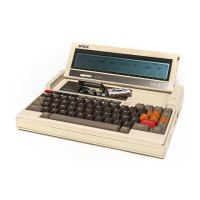REV.-A
2.1 General
This
chapter
describes various
functions
of
the
main
control
board (called MAPLE board)
which
is
the
center
of
this
computer. The
microcassette
drive and
option
units
are described in Chapter 3.
The MAPLE board uses a
diversity
of
fully
customized
ICs (referred
to
as gate arrays
throughout
this
manual), masked ROMs, and
other
chip
elements (resistor, capacitor,
transistor,
and
diode
chips)
which
simplify
component
mounting.
As
many
CMOS elements as possible have been
used in
order
to
lower
power
consumption.
In addition,
the
computer
provides
the
following
fea-
tures in
order
to
control
functions
specific
to
battery
powering:
(1) Battery backup:
Protects
data in RAM.
(2) Battery
distribution
(main and auxiliary
battery
power
supplies):
Ensures a
more
reliable
battery
backup.
(3) Charge
control:
Prevents excess Ni-Cd
battery
charging.
(4)
Power
distribution:
Outputs
the
supply
voltages
only
while
the
computer
is in
operation
in
order
to
minimize
bat-
tery
consumption.
(5)
Low
voltage
detection:
Automatically
changes
the
main
battery
to
the
auxiliary
battery
supply.
In addition,
the
computer
is provided
with
a
software
automatic
power-off
feature
which
prevents
the
battery
from
being discharged
out
if
the
computer
is
inadvertently
left
on.
2.1.1
Major
Components
The MAPLE board has elements
mounted
on
both
the
sides. A speaker and elements such as re-
sistor
packages, etc. are
mounted
on
one
side,
while
elements such as connectors,
switches,
and
LSI chips, etc. are
mounted
on
the
opposite
side as
shown
in Fig. 2-1. Table 2-1
lists
major
board elements
together
with
a
summary
of
their
function.
2-1

